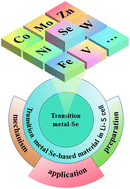Advanced preparation and application of transition metal selenides in lithium–sulfur batteries: a review
Abstract
In recent years, LSBs as a new generation of secondary batteries with high energy density have enabled large-scale energy storage. However, the high volume expansion of the sulfur cathode, the serious shuttle effect of LiPSs, and the notorious growth of lithium dendrites seriously hinder its commercial applications. Among transition metal-based materials, TMSes have good catalytic properties, electrical conductivity, lithiophilicity, and sulfiphilic properties and have become a research hotspot and are expected to be highly efficient catalysts for a novel generation of LSBs. Despite there are many reviews on LBSs, there is still a need for an overall general review on the application of TMSes in LSBs. Herein, we systematically summarize the progress made by different TMSes in the modification of LSB electrodes and separators and the fabrication of interlayers. Firstly, we elucidate the reaction mechanism of TMSes during the discharge of LSBs, and then the main preparation methods of TMSes are introduced in detail. Later, new results obtained by the modified electrodes and separators as well as the interlayers prepared by TMSes such as cobalt selenide and nickel selenide in LSBs are introduced. Finally, we put forward some insights on the development prospects of TMSes in the modification of cathodes and separators, the application of artificial intelligence, and advanced testing techniques to provide ideas for researchers.



 Please wait while we load your content...
Please wait while we load your content...